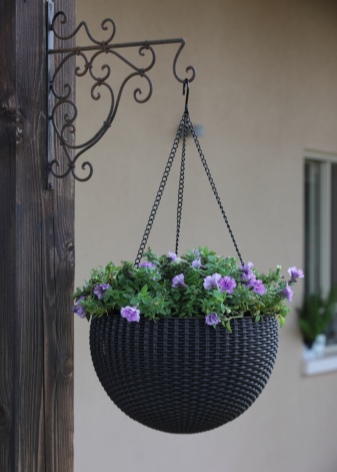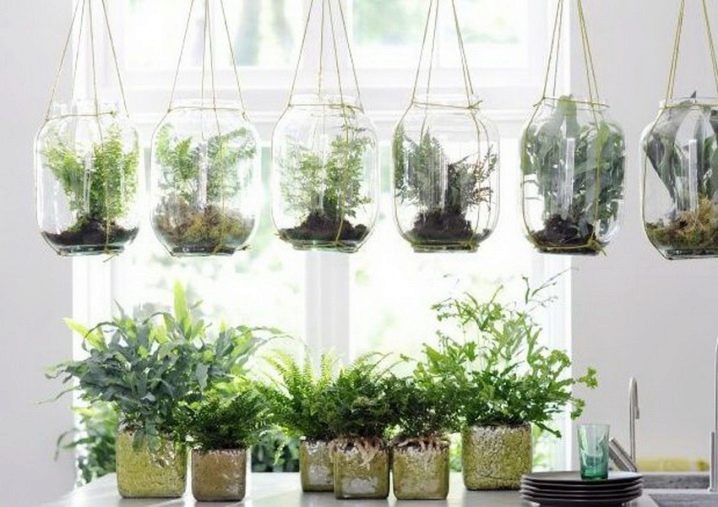How to choose a hanging planter for flowers?

The hanging planter allows you to create bright accents both indoors and outdoors or on a balcony. Although many variations of this decor item are on store shelves, self-created models from improvised items are no less beautiful.

Advantages and disadvantages
Hanging flower pots have many advantages. Since only a not too heavy object is capable of hanging, it is quite mobile and, if desired, can be easily outweighed to another place. This allows you to organize for each "green pet" the most suitable conditions for development in terms of temperature, lighting and humidity. Moreover, with a strong cold snap, all plants will be transported inside the house without any problems. In addition, such a planter does not take up space at all, which is very convenient for a situation of limited space, for example, a balcony.


Designs can combine several pots, organizing multi-level storage of flowers. The hanging vessel looks great, especially with flowers that have long hanging stems. Its independent production can be budgetary, because the most ordinary items or old, but not out of order utensils are enough. In addition, it is believed that hanging plants are minimally threatened by diseases and pests. The disadvantage of such a pots, perhaps, can be called the impossibility of using for massive heavy plants.


Views
It is customary to distinguish four main types of suspended structures. The first is hinged structures equipped with tripod-like mounts. Then it can be a pendant with chains made of metal, often forged. The chains themselves are usually located along the edges of the product. The planter can be equipped with a suspension mounted directly in the middle, or it can be any container suspended using twine or rope.


The models are also distributed according to the material used. Hanging, however, like wall-mounted pots, are often made from willow twigs. A basket is woven of them in the shape of a rectangle, circle or oval. Skilled craftsmen make wicker pots that resemble various figures of animals, plants or any other objects. Fabric pots are sewn either from felt or burlap so that the top remains open.


Decorations can be made using a variety of materials, from beads and ribbons to shells and natural materials. The fastening is made of the same fabric or strong rope, after which a pot with a plant is placed inside, and the structure is hung on a hook or directly on a fence. For the boho style, in addition, suspenders knitted from durable and moisture-repellent yarn are also suitable. Wooden planters are considered a traditional choice, suitable for almost any design. Again, it's easy to make them yourself - chop a piece of wood 20 centimeters long, and then assemble a box out of them, which is fixed with self-tapping screws. On a branch or hook, such an object will be suspended with ropes.




Homemade plastic containers are suitable for those who are not particularly concerned about the appearance of the pots. They are easy to clean and can be drained if necessary. In general, they are very user-friendly. It should be added that such a vessel does not cause overheating of the soil and the plants themselves.However, the appearance of such structures is not the most attractive - therefore, they are more suitable for placement on the balcony, and not in the interior of the apartment. Glass containers are not durable, but they always look attractive. If such a piece of furniture is created independently, then it is done using cans, glasses or even an aquarium. By connecting them with ropes, you can create a multi-level work of art.


Ceramic is a popular material for making planters, allowing you to create pots of interesting shapes and sizes. If the clay is used "neat" without glaze, it provides the correct microclimate for the plant, but the life of the item is reduced. Glazed ceramics are more durable, but they do not cope well with excess moisture and slowly let heat through. Fasteners for ceramic structures should be made of durable materials such as twine or macrame technique.


Design
Numerous variations of hanging pots, both presented in stores and made by hand, allow you to select a design for any stylistic interior design. For example, a boho-style plot is beautifully complemented by decorative elements created from old dishes, shoes and other disused items. The plant will be successfully placed in a birdcage on an iron frame, suspended on chains, or on a stand that comes with it in the kit. Having saved the lamp from bulbs and other mechanisms to the state of the cups, where the containers with plants will stand, you can turn it into a unique pots. The same applies to a vase of an unusual shape - its graceful appearance will make a beautiful hanging vessel for indoor plants.


An old watering can turns into a beautiful new planter when cleaned and repainted with durable weatherproof paint. Buckets made of different materials are no less quickly transformed. For a retro look, you can use a vintage bag to put the pots in. In this case, you don't even need to figure out how to hang it, because the strap is already there. An ordinary wicker planter can be easily transformed into a decoration for the New Year, if you place a garland between the twigs and add cones and miniature decorations to the Christmas tree as a decor.


Macrame hanging planter can be used for any shape and size potsuitable for regular and waterfall-dangling plants. It provides maximum light for the plants and also simplifies maintenance. It is better to choose a rope for such a structure from a resistant fiber, which will not be afraid of the sun, moisture, or a heavy load. When choosing a pots design, one should take into account both the material and the appearance of the plant itself, and the existing interior. For example, for a flowering plant, you should purchase monochromatic vessels, and green will be better felt in painted or decorated pots. Thus, the balance will be respected.


How to hang?
You can hang the pots with or without special mounts. For example, a decorative object on a rope is simply placed on a tree or a fence, or it is fixed with the help of special parts on a balcony, in a veranda or a gazebo. Hanging vessels are often placed on a special vertical structure with several "branches" or supports. Such furniture has mobility, which means that it can be placed in any chosen place. Most often it is made forged.

A special retractable mount is considered stylish and takes up little space. In this case, one carabiner is attached to the ceiling, and on the second, the planter itself is suspended. The mount not only looks beautiful, but also simplifies the procedure for caring for the plant, as it allows you to lower the pot down to 90 centimeters.On open verandas, a hook is most often mounted on which plants are suspended with the help of forged chains or a strong cable. Hanging from any sturdy base requires a strong twine, cord, or rope. For balconies, gazebos and stairways, there are special mesh structures with a curved mount that is fixed to the railing. The planter itself is placed in such a peculiar box. The vessels intended for the decoration of the fence are immediately made with hooks.

Beautiful examples
In the interior, decorated in the style of minimalism, you should place a ceramic planter in a noble gray shade of a regular geometric shape, for example, a triangle. It will be convenient to hang an interior part on a hook using a regular strong twine threaded through the holes made in the corners.



Outdoors, it is a good idea to hang an elegant structure consisting of a ceramic glossy bowl and a hoop base. Everything is hung on a string, which is tied into the hoop mount. A multi-tiered structure is easy to make with your own hands if there are pieces of wood of a suitable size and strong cables. Holes are cut in each plank so that the classic brown pots, again made of clay, firmly stand there. In total, no more than four such stands should be made. Between themselves they are fastened with cables passing through the holes in the corners of the boards and tied with strong knots. From above, four ropes are connected at one point, and then they are tied to a metal ring. This, in turn, will be placed on a hook that can support sufficient weight.


A stylish planter will turn out from a regular hot stand, made of light wood in the shape of a circle. Having fixed the surface on a dense rope, it will be enough just to put several miniature pots on it, for example, white ceramic pots with succulents. Another laconic model is assembled from several wooden blocks connected in the form of a square, inside which a pot is placed. A pastel rope is tied at the corners of the structure and connected at one point at the top.


Having knitted an elegant snow-white net using the macrame technique, all that remains is to place a white ceramic pot in the shape of a square with a small bush in it. The structure is fixed under the ceiling on a metal ring. Fabric pots in the form of vegetables look very cool: carrots, turnips and radishes. Small pots with growing greens are placed in them and with the help of a cord painted in the color of a vegetable, the structures are suspended from a window or fence.

For information on how to make a hanging cough with your own hands, see the next video.













The comment was sent successfully.